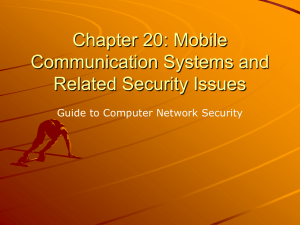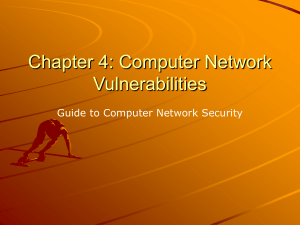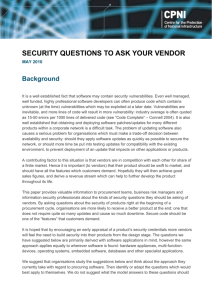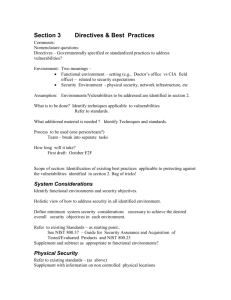Chapter 4
advertisement
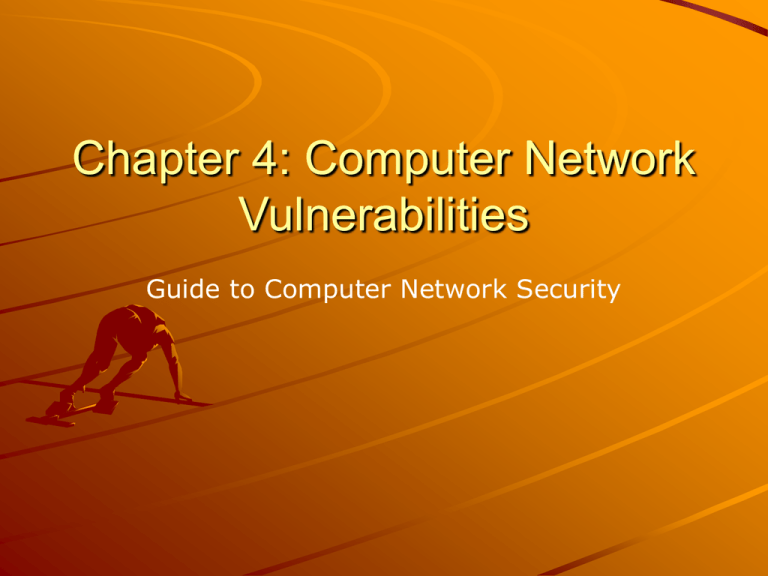
Chapter 4: Computer Network Vulnerabilities Guide to Computer Network Security Sources of Vulnerabilities There is no definitive list of all possible sources of these system vulnerabilities Among the most frequently mentioned sources of security vulnerability problems in computer networks are – – – – – – – – design flaws, poor security management, incorrect implementation, Internet technology vulnerability, the nature of intruder activity, the difficulty of fixing vulnerable systems, the limits of effectiveness of reactive solutions, social engineering Kizza - Guide to Computer Network Security 2 Computer Network Vulnerabilities System vulnerabilities are weaknesses in the software or hardware on a server or a client that can be exploited by a determined intruder to gain access to or shut down a network. A system vulnerability is a condition, a weakness of or an absence of security procedure, or technical, physical, or other controls that could be exploited by a threat Kizza - Guide to Computer Network Security 3 Design Flaws The two major components of a computer system, hardware and software, quite often have design flaws Hardware systems are less susceptible to design flaws than their software counterparts owing to less complexity and the long history of hardware engineering. But even with all these factors backing up hardware engineering, design flaws are still common. But the biggest problems in system security vulnerability are due to software design flaws Kizza - Guide to Computer Network Security 4 three major factors contribute a great deal to software design flaws: – human factors, – software complexity, – trustworthy software sources Kizza - Guide to Computer Network Security 5 Human Factors - Poor software performance can be a result of: – Memory lapses and attentional failures: For example, someone was supposed to have removed or added a line of code, tested, or verified but did not because of simple forgetfulness. – Rush to finish: The result of pressure, most often from management, to get the product on the market either to cut development costs or to meet a client deadline can cause problems. – Overconfidence and use of nonstandard or untested algorithms: Before algorithms are fully tested by peers, they are put into the product line because they seem to have worked on a few 6 Kizza - Guide to Computer Network test runs. Security – Malice: Software developers, like any other professionals, have malicious people in their ranks. Bugs, viruses, and worms have been known to be embedded and downloaded in software, as is the case with Trojan horse software, which boots itself at a timed location. – Complacency: When either an individual or a software producer has significant experience in software development, it is easy to overlook certain testing and other error control measures in those parts of software that were tested previously in a similar or related product, forgetting that no one software product can conform to Kizza - Guide to Computer Network Security 7 Software Complexity - Professionals and nonprofessionals who use software know the differences between software programming and hardware engineering. It is in these differences that underlie many of the causes of software failure and poor performance. Consider the following: – Complexity: Unlike hardwired programming in which it is easy to exhaust the possible outcomes on a given set of input sequences, in software programming a similar program may present billions of possible outcomes on the same input sequence. – Difficult testing: There will never be a complete set of test programs to check software exhaustively for all bugs for a given input sequence. – Ease of programming: The fact that software programming is easy to learn encourages many people with little formal training and education in the field to start developing programs, but many are not knowledgeable about good programming practices or able to check for errors. – Misunderstanding of basic design specifications: This affects the subsequent design phases including coding, documenting, andKizza testing. It also results in improper and 8 - Guide to Computer Network ambiguous specificationsSecurity of major components of the software and in ill-chosen and poorly defined internal Trustworthy Software Sources – – There are thousands of software sources for the millions of software products on the market today. However, if we were required to name well known software producers, very few of us would succeed in naming more than a handful. Yet we buy software products every day without even ever minding their sources. Most important, we do not care about the quality of that software, the honesty of the anonymous programmer, and of course the reliability of it as long as it does what we want it to do. – Even if we want to trace the authorship of the software product, it is impossible because software companies are closed within months of their opening. Chances are when a software product is 2 years old, its producer is likely to be out of business. In addition to the difficulties in tracing the producers of software who go out of business as fast as they come in, there is also fear that such software may not even have been tested at all. – The growth of the Internet and the escalating costs of software production have led many small in-house software developers to use the marketplace as a giant 9 Kizza - Guide to Computer Network testing laboratory through the use of beta testing, Security shareware, and freeware. Shareware and freeware have a Software Re-Use, Re-engineering, and Outlived Design – New developments in software engineering are spearheading new developments such as software re-use and software re-engineering. Software re-use is the integration and use of software assets from a previously developed system. It is the process in which old or updated software such as library, component, requirements and design documents, and design patterns is used along with new software. – Both software re-engineering and re-use are hailed for cutting down on the escalating development and testing costs. They have brought efficiency by reducing time spent designing or coding, popularized standardization, and led to common “look-andfeel” between applications. They have made 10 Kizza - Guide to Computer Network debugging easier through use of thoroughly Security tested designs and code . Poor Security Management Security management is both a technical and an administrative security process that involves security policies and controls that the organization decides to put in place to provide the required level of protection. In addition, it also involves security monitoring and evaluation of the effectiveness of those policies. The most effective way to meet those goals is to implement security risk assessment through a security policy and securing access to network resources through the use of firewalls and strong cryptography. These and others offer the security required for the different information systems in the organization in terms of integrity, confidentiality, and availability of that information. Security management by itself is a complex process; however, if it is not well organized it can result in a security nightmare for the organization. Poor security management is a result of little control over security implementation, administration, and monitoring. It is a failure in having solid control of the security situation of the organization when the security administrator does not know who is setting the organization’s security policy, administering security compliance, and who manages system security configurations and is in charge of security event and incident handling. Kizza - Guide to Computer Network Security 11 Good security management is made up of a number of implementable security components that include risk management, information security policies and procedures, standards, guidelines, information classification, security monitoring, security education. – These core components serve to protect the organization’s resources. – A risk analysis will identify these assets, discover the threats that put them at risk, and estimate the possible damage and potential loss a company could endure if any of these threats become real. The results of the risk analysis help management construct a budget with the necessary funds to protect the recognized assets from their identified threats and develop applicable security policies that provide direction for security activities. Security education takes this information to each and every employee. – Security policies and procedures to create, implement, and enforce security issues that may include people and technology. – Standards and guidelines to find ways, including automated solution for creating, updating, and tracking compliance of security policies across the organization. Kizza - Guide to Computer Network Security 12 – Information classification to manage the search, identification, and reduction of system vulnerabilities by establishing security configurations. – Security monitoring to prevent and detect intrusions, consolidate event logs for future log and trend analysis, manage security events in real-time, manage parameter security including multiple firewall reporting systems, and analyze security events enterprise-wide. – Security education to bring security awareness to every employee of the organization and teach them their individual security responsibility. Kizza - Guide to Computer Network Security 13 Incorrect Implementation Incorrect implementation very often is a result of incompatible interfaces. Two product modules can be deployed and work together only if they are compatible. That means that the module must be additive, that is the environment of the interface needs to remain intact. An incompatible interface, on the other hand, means that the introduction of the module has changed the existing interface in such a way that existing references to the interface can fail or behave incorrectly. Kizza - Guide to Computer Network Security 14 Incompatibility in system interfaces may be cause by a variety of conditions usually created by things such as: – Too much detail – Not enough understanding of the underlying parameters – Poor communication during design – Selecting the software or hardware modules before understanding the receiving software – Ignoring integration issues – Error in manual entry Kizza - Guide to Computer Network Security 15 Internet Technology Vulnerability The fact that computer and telecommunication technologies have developed at such an amazing and frightening speed and people have overwhelmingly embraced both of them has caused security experts to worry about the side effects of these booming technologies. Internet technology has been and continues to be vulnerable. There have been reports of all sorts of loopholes, weaknesses, and gaping holes in both software and hardware technologies. No one knows how many of these vulnerabilities there are both in software and hardware. The assumption is that there are thousands. As history has shown us, a few are always discovered every day by hackers Kizza - Guide to Computer Network Security 16 Although the list spans both hardware and software, the problem is more prevalent with software. In fact software vulnerabilities can be put into four categories: – Operating system vulnerabilities: Operating systems are the main sources of all reported system vulnerabilities. – Port-based vulnerabilities: Besides operating systems, network service ports take second place is sourcing system vulnerabilities. For system administrators, knowing the list of most vulnerable ports can go a long way to help enhance system security by blocking those known ports at the firewall. – Application software based errors – System protocol software such as client and 17 Kizza - Guide to Computer Network Security server browser. Changing Nature of Hacker Technologies and Activities It is ironic that as “useful” technology develops so does the “bad” technology. What we call useful technology is the development in all computer and telecommunication technologies that are driving the Internet, telecommunication, and the Web. “Bad” technology is the technology that system intruders are using to attack systems. Unfortunately these technologies are all developing in tandem. In fact there are times when it looks like hacker technologies are developing faster that the rest of the technology. One thing is clear, though: hacker technology is flourishing. 18 Kizza - Guide to Computer Network Security Difficulty of Fixing Vulnerable Systems It is difficult to fix known system vulnerabilities. There is concern about the ability of system administrators to cope with the number of patches issued for system vulnerabilities. As the number of vulnerabilities rises, system and network administrators face a difficult situation. They are challenged with keeping up with all the systems they have and all the patches released for those systems. Patches can be difficult to apply and might even have unexpected side effects as a result of compatibility issues [2]. Beside the problem of keeping abreast of the number of vulnerabilities and the corresponding patches there are also logistic problems between the time a vendor releases a security patch, and the time a system administrator fixes the vulnerable computer system. There are several factors affecting the quick fixing of patches. Sometimes it is the logistics of the distribution of patches. Many vendors disseminate the patches on their Web sites; others send e-mail alerts. However, sometimes busy systems administrators do not get around to these e-mails and security alerts until sometime after.Network Sometimes it can be 19 Kizza - Guide to Computer Security months or years before the patches are implemented on a majority of the vulnerable computers. Limits of Effectiveness of Reactive Solutions Because just a small percentage of all attacks is reported, this indicates a serious growing system security problem. Urgent action is needed to find an effective solution to this monstrous problem. The security community, including scrupulous vendors, have come up with various solutions, some good and others not. In fact, in an unexpected reversal of fortunes one of the new security problems is to find a “good” solution from among thousands of solutions and to find an “expert” security option from the many different views. Are we reaching the limits of our efforts, as a community, to come up with a few good and effective solutions to this security problem? There are many signs to support an affirmative answer to this question. Kizza - Guide to Computer Network Security 20 It is clear that we are reaching the limits of effectiveness of our reactive solutions. Richard D. Pethia gives the following reasons: – The number of vulnerabilities in commercial off-the-shelf software is now at the level that it is virtually impossible for any but the best resourced organizations to keep up with the vulnerability fixes. – The Internet now connects more than 109,000,000 computers and continues to grow at a rapid pace. At any point in time, there are hundreds of thousands of connected computers that are vulnerable to one form of attack or another. – Attack technology has now advanced to the point where it is easy for attackers to take advantage of these vulnerable machines and harness them together to launch high-powered attacks. – Many attacks are now fully automated, thus reducing the turnaround time even further as they spread around cyberspace. – The attack technology has become increasingly complex and in some cases intentionally stealthy, thus reducing the turnaround time and increasing the time it takes to discover and analyze the attack mechanisms in order to produce antidotes. – Internet users have become increasingly dependent on the Internet and now use it for many critical applications so that a relatively minor attack has the potential to cause huge damages. Kizza - Guide to Computer Network Security 21 Social Engineering Social engineering is an outside hacker's use of psychological tricks on legitimate users of a computer system, in order to gain the information (usernames and passwords) one needs to gain access to the system. Social engineering is a diversion, in the process of system attack, on people’s intelligence to utilize two human weaknesses: first no one wants to be considered ignorant and second is human trust. Ironically these are two weaknesses that have made social engineering difficult to fight because no one wants to admit falling for it. This has made social engineering a critical system security hole. Kizza - Guide to Computer Network Security 22 Vulnerability Assessment Vulnerability assessment is a process that works on a system to identify, track, and manage the repair of vulnerabilities on the system. The assortment of items that are checked by this process in a system under review varies depending on the organization. It may include all desktops, servers, routers, and firewalls. Most vulnerability assessment services will provide system administrators with: – network mapping and system finger printing of all known vulnerabilities – a complete vulnerability analysis and ranking of all exploitable weaknesses based on potential impact and likelihood of occurrence for all services on each host – prioritized list of misconfigurations. Kizza - Guide to Computer Network Security 23 A final report is always produced detailing the findings and the best way to go about overcoming such vulnerabilities. This report consists of: – prioritized recommendations for mitigating or eliminating weaknesses, – based on an organization’s operational schedule, it also contains recommendations of further reassessments of the system within given time intervals or on a regular basis. Kizza - Guide to Computer Network Security 24 Vulnerability Assessment Services Due to the massive growth of the number of companies and organizations owning their own networks, the growth of vulnerability monitoring technologies, the increase in network intrusions and attacks with viruses, and world-wide publicity of such attacks, there is a growing number of companies offering system vulnerability services Among the services are: – Vulnerability Scanning - to provide a comprehensive security review of the system including both the perimeter and system internals. The aim of this kind of scanning is to spot critical vulnerabilities and gaps in the system’s security practices. Comprehensive system scanning usually results in a number of both false positives and negatives. It is the job of the system administrator to find ways of dealing with these false positives and negatives. The final 25 Kizza - Guide to Computer report produced after each scanNetwork consists of strategic advice Security and prioritized recommendations to ensure critical holes Vulnerability Assessment and Penetration Testing - a hands-on testing of a system for identified and unidentified vulnerabilities. All known hacking techniques and tools are tested during this phase to reproduce realworld attack scenarios. One of the outcomes of these real-life testings is that new and sometimes obscure vulnerabilities are found, processes and procedures of attack are identified, and sources and severity of vulnerabilities are categorized and prioritized based on the user-provided risks. Kizza - Guide to Computer Network Security 26 Advantages of Vulnerability Assessment Services They can, and actually always do, provide and develop signatures and updates for new vulnerabilities and automatically include them in the next scan. This eliminates the need for the system administrator to schedule periodic updates. Probably the best advantage to an overworked and many times resource strapped system administrator is the automated and regularly scheduled scan of all network resources. They provide, in addition, a badly needed third-party “security eye.” thus helping the administrator to provide an objective yet independent security evaluation Kizza - Guide to Computer Network Security 27
